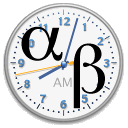
TDF Plan: Preference settings
|
Database Settings:
TDF Plan uses a database to keep track of patients. The database is included in the TDF PLan application and its files reside on the same computer that TDF Plan is running on. At extra expense, you can use a remote database server so that the patient database can be shared among many computers.
- Local database file: The absolute file path to the local Real SQL database. Leave this field blank to use the default file TDFDatabase.rsd in the TDF Plan application folder.
- Remote database: The name of the database on the remote SQL server. Leave this field blank to use the default name TDFDatabase.
- Server: This menu selects between a local database (REAL SQL) hosted on the TDF Plan computer or remote database server. The local database file resides in the TDF Plan folder and is named TDFDatabase.rsd. A remote server such as REAL SQLServer can also be used if TDF Plan will be run on multiple computers within a department.
- Host: This is the IP address of the remote server host.
- Port: This is the IP port of the remote server, REAL SQLServer defaults to port 4430.
- Username: A username to access the remote server.
- Password: A password to access the remote server.
- Timeout: If the server doesn't respond within this time, give up.
- Housekeeping: Automatically delete completed patients from the server in order to keep memory and file size reasonable.
- Patient files: When patients are added to the database, you can also automatically save a local copy of the patient file. This provides a backup, but can also lead to a large number of local files in the TDF Patients folder which can eventually slow down TDF Plan. Housekeeping for local files must be managed manually.
- Connect: Manually reconnects to the current database.
|
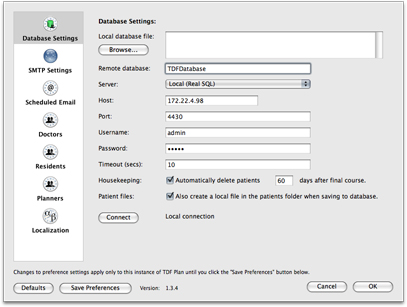
|
|
SMPT Settings:
Simple Mail Transfer Protocol (SMTP) is the de facto standard for e-mail transmissions across the Internet
- Server: The address of your email server.
- Port: The IP port of your email server.
- Username: Your email user name.
- Password: Your email password.
- Authentication: Email servers require authentication (a username and password) before sending or receiving email in order to provide security and reduce spam.
|
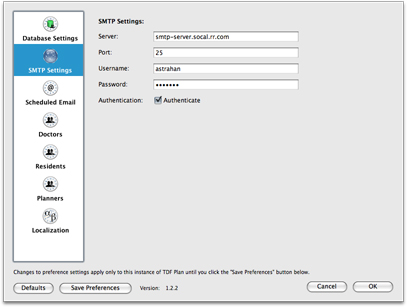
|
|
Scheduled Email Settings:
TDF Plan will look through the patients in its database once per day and generate email alerts of impending course changes to the staff (doctors, residents, planners and others) associated with that patient. In order to use this feature effectively, TDF Plan must be running with scheduled email enabled at the designated send time.
- From: The email address that TDF Plan will use when sending email.
- Subject: The subject line of the email header.
- Send at: The time of day to send email, very early morning (e.g. 4:00 AM) is probably the best time.
- Look ahead: The number of days ahead to look for course changes.
- Email: Check to enable scheduled email. When running TDF Plan on multiple computers within a department, this feature should only be enabled on one of the computers.
|
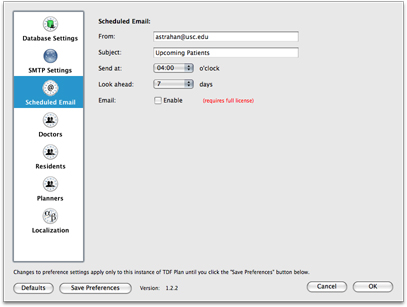
|
|
Doctors, Residents and Planners:
TDF Plan will manage lists of the doctors, residents and planners associated with your department. The list consists of the name and email address of each staff member. If the Email column is checked, that person is eligible to receive scheduled email regarding their patients. The Schedule column indicates which week days email can be sent. In this example, the entry "23456" encodes M-F as allowable email weekdays. "1234567" would encode the full week, Sun-Sat.
- Add: Add a new name to the list.
- Delete: Delete the selected name from the list.
- Sort: Sort the list alphabetically.
- Save: Update the list file or database.
- Store list in the SQL database: The list of staff can be stored locally as text files in the TDFStaff folder or in a table in the SQL database (or both). If unchecked, the local text files are used. Storing the staff lists on a remote database allows a single list to be shared by every instance of TDF Plan in your department.
- Copy List to SQL: Uploads the current list (e.g. from the local text files) to the SQL server table.
|
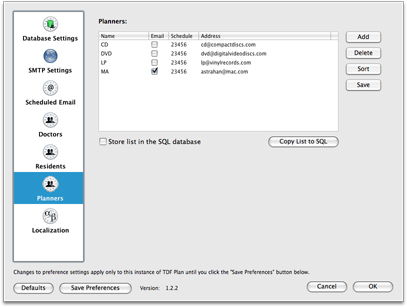
|
|
Localization Settings:
These are the default settings that TDF Plan uses when creating new patients. Treatment courses can be customized on a per course basis to override these settings.
- Holidays: Your country. Select "none" to disable this feature.
- Clinic: The name of your clinic, department or institution.
- Data folder: The folder where application support files reside. Leave blank to use the default which is the folder the application resides in (e.g. TDF_Plan).
- Patients folder: The absolute file path to the folder in which you want to store patient files. Leave blank to use the default TDFPatients folder in the TDF Plan application folder.
- Billing code: TDF Plan calculations are billable as basic physics calculations.
- Std. week: The common work/treatment week is M-F with Saturday-Sunday as the weekend. You can customize the default treatment week to fit your needs.
- Tx days/week: Usually patients are treated 5 days per week, but you can customize the default to fit your needs.
- Other radionuclide:
- Thalf: User definable halflife (in days) for the 'Other' radionuclide menu item used in brachytherapy calculations. Defaults to 10 days.
- RBE: User definable RBE for the 'Other' radionuclide menu item used in brachytherapy calculations. Defaults to 1.0.
- Updates: When checked, TDF Plan will test at startup to see if there is a newer version of itself available. No information is sent out from your computer, the program just accesses data in a text file on the TDF Plan web server.
- Timeout: Internet timeout.
- NTT file: The Normal Tissue Tolerance file name.
- Makeup warning: The warning threshold for makeup regimen dose per fraction expressed as a percentage of the originally intended regimen’s dose per fraction (defaults to 15%).
|
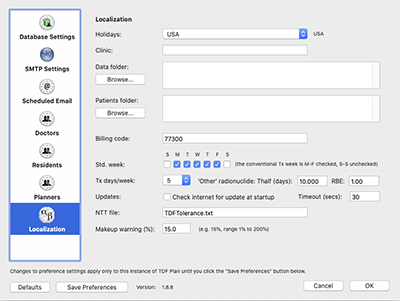
|





